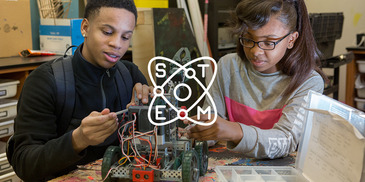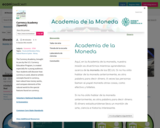
Students compare univariate data distributions using statistical concepts like box plots, stem plots, and histograms.
- Subject:
- Mathematics
- Science
- Material Type:
- Lesson Plan
- Provider:
- Texas Instruments
- Date Added:
- 08/07/2023

STEM goes beyond educational trends and stand-alone subjects. It's a dynamic approach to teaching, interweaving technology, real-world problems, cross-curricular themes, student choice, and project-based tasks to create learning that engages and challenges.
Use the filters on the left to refine the results.

Students compare univariate data distributions using statistical concepts like box plots, stem plots, and histograms.

A video lesson combined with student group work about the desalination of seawater in areas where there is little access to freshwater.

Students investigate the relationship between proteins and amino acids digested in the small intestine while examining overall cell structure and function.

How does the shape of a cam affect the motion of a mechanism or machine? Explore the types of cam and follower mechanisms to identify how they transfer motion in machines. Engineering a mechanical device involves designing with a result in mind. This challenge will ask students to explore math, science and engineering design through the device of cam and follower.
This is a 4-hour lesson that includes a self-paced interactive module and classroom activities. The teacher guide includes a challenge sequence (timeline), relevance to standards, materials list, assessment, evaluation rubric, and learning extensions.
Lesson objectives: (1) Identify types of cam and follower and how they are connected to levers and mechanisms. (2) Differentiate the shapes of cams and the movement created. (3) Design, build and demonstrate your cam and follower mechanism.

A fun lesson plan for younger students incorporating art, math, and writing. Student create their own counting stories, and illustrate them. Also provides resources and adaptations. (To access this lesson plan, you must register with Crayola.com. Registration is free and takes only a few moments to complete.)

How do shape and weight impact the performance of a fidget spinner? This challenge will explore how shapes, weight and force impact the performance of a fidget spinner. Engineering a mechanical device involves designing with a result in mind. This challenge will ask students to explore math, science and engineering design through the device of a fidget spinner.
This is a 3-hour lesson that includes a self-paced interactive module and classroom activities. The teacher guide includes a challenge sequence (timeline), relevance to standards, materials list, assessment, evaluation rubric, and learning extensions.
Lesson objectives: (1) Investigate the basic shapes that make up a fidget spinner. (2) Explore how a fidget spinner works. (3) Design, build and test your own fidget spinner.

What if students could see the relevance of their school curriculum to real-world, interesting, STEM-related careers? Let's help them create a great future!

In the video, Curious George wants to make Compass the Pigeon the perfect perch so the bird can feel right at home. But it takes a lot of research to figure out how to build a tall object that won't collapse. Students learn about the design process by researching their ideas outdoors, experimenting with what it takes to make a tall object stand upright and be stable, then comparing and documenting their work. Includes background reading, student handout, and lesson plan. [2:05]

In a clip from Curious George, investigate with George how wind can move things. [2:05]

See how George uses his five senses (smell, touch, sight, hearing, and tasting) to identify how to keep deer from eating his flowers. [2:03]

A clip from Curious George showing students how a work of art can be made from a "junk" pile. [1:20]

Investigate how to graph with Curious George as he sorts library books in this video. [2:03]

The Currency Academy, brought to you by the U.S. Currency Education Program, is created especially for a young audience. Your students will discover how currency is used, observe artistic concepts found in currency, learn about how money works, and compare elements of the natural world to the special features found on currency. This content from Econ Lowdown also features alignment to national Financial Literacy and/or Economics standards.

The Currency Academy, brought to you by the U.S. Currency Education Program, is created especially for a young audience. Your students will discover how currency is used, observe artistic concepts found in currency, learn about how money works, and compare elements of the natural world to the special features found on currency. This content from Econ Lowdown also features alignment to national Financial Literacy and/or Economics standards.

Meet Denise, or "Seven" as her friends call her, a welder, artist and instructor who forged her own path as a woman in the trades. Support materials are provided. This video is part of the series SciGirls Profiles: Women in STEM, which includes 12 role model videos of women who are passionate about their STEM work, hobbies, families and making the world a better place. These videos introduce students to women working in traditionally male STEM occupations, and inspire them around career exploration in fields like technology, engineering, manufacturing and trades. Each video provides explicit strategies for overcoming barriers and finding success and joy in jobs where women are heavily underrepresented. [5:04]

How are species able to survive in a desert? tudents will be able to explain how plants and animals are adapted to a desert and how those adaptations help them survive and reproduce.

In this two-part activity, students design and build a Rube Goldberg machine. The open ended problem uses the engineering design process and can have a preset purpose, such as rolling a marble into a cup from a distance, or can be left for the students to decide.

Through discussion and hands-on experimentation, students learn about the geological (ancient) carbon cycle. They investigate the role of dinosaurs in the carbon cycle and the eventual storage of carbon in the form of chalk. Students discover how the carbon cycle has been occurring for millions of years and is necessary for life on Earth. Finally, they may extend their knowledge to the concept of global warming and how engineers are working to understand the carbon cycle and reduce harmful CO2 emissions.

Bridgette's formula for success is using her love of chemistry to develop groundbreaking products at work and create natural remedies for her family at home. This video is part of the series SciGirls Profiles: Women in STEM, which includes 12 role model videos of women who are passionate about their STEM work, hobbies, families and making the world a better place. These videos introduce students to women working in traditionally male STEM occupations, and inspire them around career exploration in fields like technology, engineering, manufacturing and trades. Each video provides explicit strategies for overcoming barriers and finding success and joy in jobs where women are heavily underrepresented. Support materials are provided. [4:28]

The DriveOhio Ambassador Program aims to inspire and educate Ohio high school students about career opportunities in the transportation industry. The program offers students access to online resources, hands-on activities, and real-world experiences to help them develop the skills and knowledge needed to pursue a career in a STEM-related field. Other benefits include earning volunteer or work-based learning hours aligned with the Ohio Means Jobs Readiness Seal, opportunities to earn industry recognized credentials, career networking with Ohio employers, universities, and researchers, and mentoring experience.